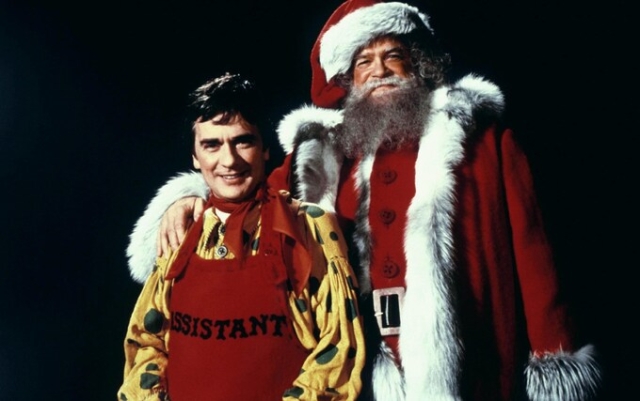 Dudley Moore and David Huddleston in The Santa Claus: The Movie Posted by Alami
Dudley Moore and David Huddleston in The Santa Claus: The Movie Posted by Alami
It's getting earlier every year. That's what the Grinches say in November — as soon as the supermarkets put out their decorations and pounce on Slade. Back in the early 1980s, the hype around Santa Claus (more specifically, The Santa Claus: The Movie starring Dudley Moore as the wayward elf) began more than three years earlier.
In the summer of 1982, father-and-son producers Alexander and Ilya Salkind—also producers of the Superman films—placed a six-page ad in Variety magazine announcing their upcoming blockbuster film about Santa Claus. Ilya Salkind stated that it could be «the most expensive picture ever made» and that scenes would be filmed in «virtually every capital city in the world.» Fifteen propeller-driven planes flew the Santa Claus banner over the 1984 Cannes Film Festival, and American newspapers reported that a herd of reindeer flew to the London set (presumably also by plane).
As promised, the film, which was eventually released in 1985, really turned out to be expensive. It cost a whopping $50 million, which was more than each of the Salkinds' Superman films cost. The budget, as Ilya Salkind explained, was determined by “the cost of lifting 13 deer and a very fat actor into the air.” In addition, producers built an epic grotto and elf workshop on the 007 stage at Pinewood Studios. Dudley Moore, then at the height of his Hollywood success as a sleazy sex symbol, alone cost the film $5 million.
Actor John Lithgow, who played the villain, a crooked toymaker, recalled the film in an interview with James Corden in 2020. Forget the red suit. The promotion of The Santa Claus as the most expensive film of all time was a «red flag,» Lithgow said. The ever-favorite Lithgow called it «the worst film I ever made.» Indeed, some holiday viewers rate “The Santa Claus: The Movie” as an overcooked Christmas turkey. The film tanked (flying reindeer and all) at the US box office, where it failed to recoup even half of its $50 million budget.
But it wasn't a complete Christmas disaster. “It was a great success in England,” says Ilya Salkind, speaking from the United States. It remains a firm favorite here — a staple of Christmas TV. The newly remastered Santa Claus: The Movie is back in UK cinemas and is available on 4K Blu-ray.
 < p>The hype may have been big—the cinematic equivalent of a belly that rocks like a bowl of jelly (a line that clearly upsets the film's body-conscious Santa)—but the Salkinds knew how to make a blockbuster. They made Superman a major movie franchise and created what is still the basis for superhero movies today.
< p>The hype may have been big—the cinematic equivalent of a belly that rocks like a bowl of jelly (a line that clearly upsets the film's body-conscious Santa)—but the Salkinds knew how to make a blockbuster. They made Superman a major movie franchise and created what is still the basis for superhero movies today.
Santa Claus: The Movie is an often-told story: When the Superman franchise took a nosedive with Superman III and Supergirl (both disappointments in 1983 and 1984, respectively), the Salkinds began looking for another iconic name to spin into a multi-film franchise . and rather cynically landed on Santa Claus. Of course, it was part of Salkind's formula to take well-established tropes and put them in rowdy adventure films (The Three Musketeers and Christopher Columbus also received the Salkind treatment).
In the early 1980s, Santa Claus was perhaps the only name that gave Superman a run for his money when it came to iconic status as a benefactor. But according to Ilya Salkind, now 76, it wasn't all that cynical. “No, no, no,” he says over the phone from California. “One day I said, let’s make a movie about Santa Claus, the most enduring legend of all time!”
As Salkind said when promoting The Santa Claus, the project was a decade in the making—he first came up with the idea for a big-budget Santa in 1975. “It was a dream I had for 10 years,” he said. Santa Claus: However, the film has a lot in common with Superman. Essentially, the story is about a man with a big heart, endowed with magical powers, including the ability to fly, who contributes to the good of humanity. «The origin story of Santa Claus has never been done before,» Salkind told Super Site in 2010. “And I wanted to make a film that explained how he came to be, not who he is.”
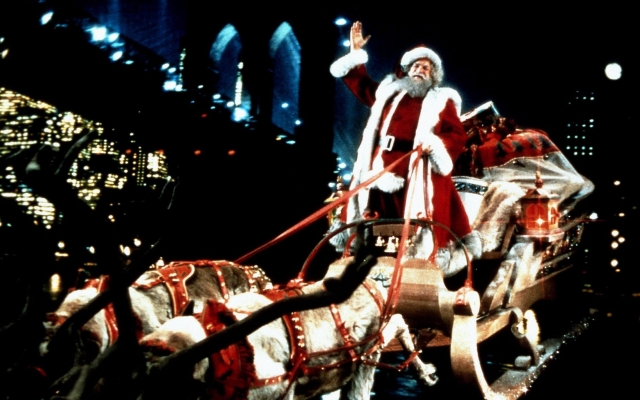 David Huddleston as Saint Nick in «Father Christmas: The Movie» Author: Alami
David Huddleston as Saint Nick in «Father Christmas: The Movie» Author: Alami
Ilya Salkind was not the only one who believed in Santa Claus. Media Home Entertainment received $2.6 million, its largest home video rights award to date.
The screenplay was written by married couple David and Leslie Newman, who also worked on the Superman films, but Salkind came up with the story himself. He drew on various legends about Santa Claus, most notably the gift-giving antics of St. Nicholas. Salkind's producer Pierre Spengler called their version a «true legend» of Santa Claus. Ask any '80s kid to tell you the story of Santa, and I bet they'll tell you at least part of the version seen in the movie.
Klaus stars David Huddleston, a kindly medieval woodcutter who travels to a nearby village every Christmas to give away handmade toys. When Klaus and his wife (Keeping Up Appearances' Judy Cornwell) become stranded in a snowstorm, they are rescued by elves and magically transported to the North Pole. The elves grant Mr. and Mrs. Claus eternal life and task the newly named Santa with delivering their toys to children around the world on Christmas Eve (all of which sounds exhausting).
There has been some criticism that it is an Americanized version of Santa. In the film's defense, much of what comes to mind when we think of Santa (or Father Christmas for us Brits) — the red suit, the sleigh, the reindeer — are American inventions. But with production scheduled to take place at Pinewood Studios, actors' union Equity wanted a Brit to play the role and tried to block David Huddleston's application for a work permit. Regardless of nationality, Huddleston was committed to the role. He piled 36 pounds onto an already large and cheerful frame and sums up the film perfectly: a big, shimmering lump of corn.
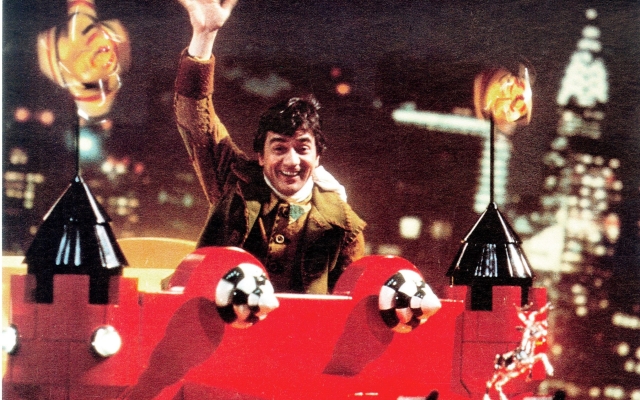 Dudley Moore in The Santa Claus: The Movie Author: Alami
Dudley Moore in The Santa Claus: The Movie Author: Alami
After befriending a homeless boy, Joe (Christian Fitzpatrick), his Santa is shocked to find Joe sleeping in his doorway. “But today is Christmas Eve! Don't you know what this means? asks Santa with the same smug condescension as in Band Aid's «Do They Know It's Christmas.» However, Huddleston is the most popular Santa Movie, along with Tim Allen and Billy Bob Thornton, although once you find out he's also the Big Lebowski — a wheelchair-bound millionaire who refuses to reimburse the cost of the Dude's piss-rug , — it’s difficult to do this. do not see under the beard and hat.
Various directors were considered for the role of Santa Claus: Roger Donaldson (The Bounty), Robert Wise (West Side Story), Walter Hill (The Warriors) and, most incredibly, horror maestro John Carpenter, who was then in the middle of a series films «Santa Claus». these included Escape from New York, The Thing and Big Trouble in Little China. “He would be an interesting director,” Salkind admits. But, as the Christmas tale goes, Carpenter wanted too much creative control and cast the delightfully menacing Brian Dennehy—then best known as the less-than-hospitable sheriff in First Blood—as Old St. Nick. Instead, the Salkinds turned to French director Jeannot Schwartz, who also directed Supergirl for them. «Finally we said, 'Let's go with a guy we know,'» Salkind recalls. “He was always on time and very, very, very reliable.” Completing the $50 million production on time and on budget was critical.
Another big name nearly slid down the production chimney: Paul McCartney. Macca was in talks to create a song for the film. “Unfortunately, I met Paul—in London, I think—and he didn’t want to do it,” Salkind says. The movie's ending theme, «It's Christmas (Around the World),» is sung by Sheena Easton.
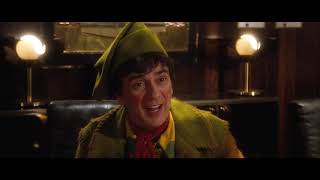
However, Dudley Moore never doubted. The role of Patch (originally called Scratch, but renamed after Dudley's son, Patrick) was written for him. “He was very short,” Salkind says of the 5-foot-2 Moore. “He was the perfect elf… He was a very sweet, wonderful guy. He had a moment where he was a very big star. It cost us 5 million dollars!”
Moore became an unlikely sex symbol with the release of the 1979 comedy «Ten» with Bo Derek — or the «sex thimble» as the press called him. Moore confirmed that there will be no funny business at the North Pole. “Yeah, no sex,” Moore told reporters after being cast in “The Santa Clause.” “In a way it’s a pity. This instinctively bothers me since I did the movie 10.”
Moore's film career actually peaked with The Ten and Arthur. Now he's starred in several twisted films, including Unfaithfully Yours, Lovesick, Arthur 2: On the Rocks and Like Father, Like Son. Alexander Games, author of Pete & Dud listed the failures of Moore's film and described The Santa Clause: The Movie in one word: «Doomed.»
Moore was joined by hundreds of supporting elves, all men about five feet tall. To hire so many elf-sized men, the producers had to recruit them from outside the acting profession. Some apparently decided to pursue an acting career after The Santa Claus: The Movie. “Ah, competition at last,” Moore said. Although, when he also thought that the sight of him and all the other elves together was «fucking funny.»
According to Moore's biographer Barbra Paskin, he entertained other actors between takes with foul language — such as the foul-mouthed Derek and Clive, whom he played with comedy partner Peter Cook.
The Salkinds' specialty was the creation of two films from one production. The Three Musketeers, starring Oliver Reed, Michael York and Raquel Welch, was split into two films, with Superman and Superman 2 supposed to film simultaneously (although that didn't quite work out). Santa Claus: The film is almost like two films, although Salkind says he had no plans to create a Santa Claus verse: «The film itself ends very clearly,» he says. «I don't think the idea was to do another Santa Claus,» although there was talk of a sequel at the time.
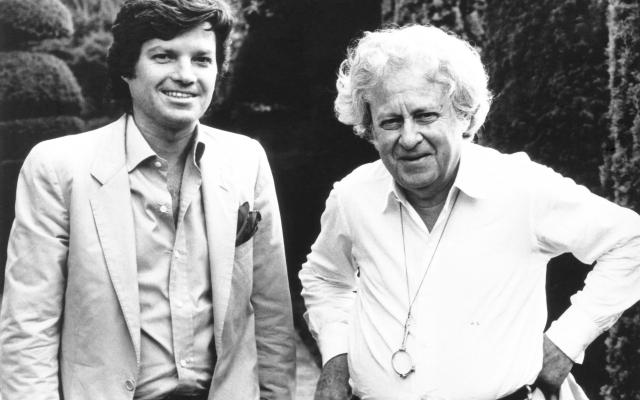 Santa Claus and Superman — producers Ilya and Alexander Salkind Photo: Alami
Santa Claus and Superman — producers Ilya and Alexander Salkind Photo: Alami
In the first half, Santa gains his powers and gains skills as a gift giver. In the second half, Patch attempts to automate Santa's workshop with disastrous results — hinting at some scenes that shouldn't be laughed at as children's toys fall apart at Christmas («Perhaps we could make some kind of statement?» asks the executive). an elf plunging his curly boot into the world of PR). Ashamed, Patch goes AWOL and teams up with John Lithgow's toymaker, BZ, a corporate scoundrel who fills plush toys with broken glass and nails. Taking advantage of Patch's gifts (sweets soaked in flying reindeer dust), BZ plans to launch its own cash cow holiday, «Christmas 2», on March 25th. This is the most poignant idea of the film. BZ was way ahead of the events that eventually gave us Black Friday and Prime Day.
There is an irony to the film's anti-corporate message and its opposition to the commercialization of Christmas, undermined by the fact that the film is essentially a cash-in on the Santa Claus brand, hence The Santa Claus: The Movie. This is the ultimate spin-off, Santa's Spicy World. There is also some striking product placement. Poor homeless Joe looks out of a McDonald's window — longing for Big Macs — at a time when McDonald's sponsored several film screenings in the US and gave away storybooks along with its Happy Meals.
However, Salkind was a moralist about Santa Claus. “This is not just a movie,” he told the press. “This is something more — this is a picture of my life. We hope to help bring back values with this story of a good man who simply gives back.” Looking back, Salkind is still a fan. “Honestly, I was very pleased with the film.”
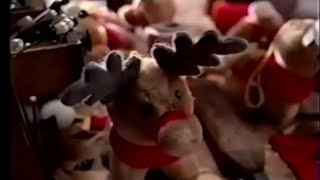
John Lithgow was less celebratory. “When it was done, Dudley and I sat alone in the Pinewood Studios screening room and watched it together,” he told James Corden. “And we kind of walked out of the cinema shaking our heads. I think I remember him using the word «career-ending.»
The Santa Claus: The Movie was released in the United States over Thanksgiving weekend 1985. “It started off well,” says Salkind, “but it didn’t last so well. I think one of the reasons is that we should have opened earlier.” Santa Claus was ultimately destroyed by Rocky IV at the box office. In the US, it earned just $23.7 million.
But is Santa Claus: The Movie really a Christmas turkey? It often finds its way onto «worst Christmas movies» lists, which seems harsh when nauseating films like Love Actually and The Holiday continue to clog ITV4 all winter. John Lithgow is — despite what he thinks — simply handsome, and the scale of the production is impressive (though it's better appreciated in the making of a documentary). And the animatronic deer, whose job it is to play an actual role: mostly looking irritated, irritable, or afraid of heights, are better than anything CGI can pull out of a magic bag. (Their real-life deer counterparts were released in English parks. «If we sent them back to Lapland, they'd turn into steaks,» Salkind said in 1985.
Perhaps they're British. The 80's child in me speaks. The Santa Claus: The Movie grossed a respectable £5 million at the UK box office, becoming the No. 7 film of 1985, and has been repeated at Christmas ever since. Even Lithgow had to admit that this is the source of Christmas cheer in this country. “I found this seasonal favorite in England,” he said. “This is your version of It's a Wonderful Life.”
I wouldn't go that far, but it's no surprise that we like Santa Claus: The Movie. It's bloated, overpriced, tasteless, and enjoyed purely for nostalgia. Indeed, it's a bit like Christmas itself.


























































Свежие комментарии